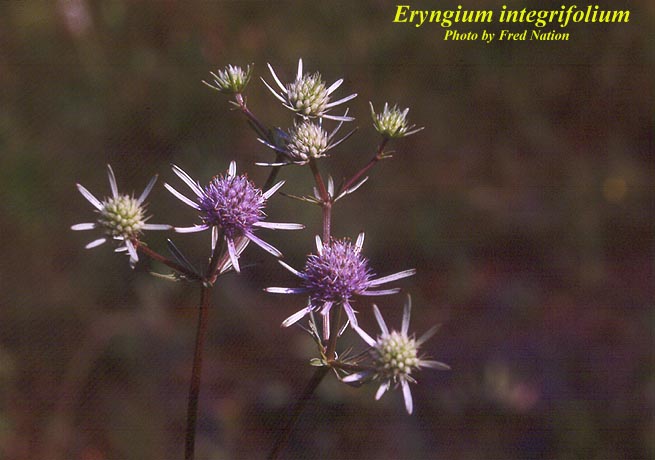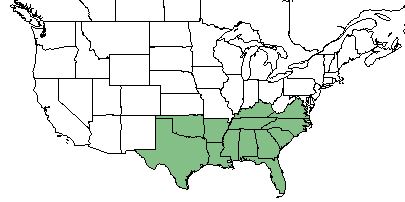Difference between revisions of "Eryngium integrifolium"
(→Ecology) |
|||
| Line 34: | Line 34: | ||
Associated species include ''Juncus trigonocarpus'', ''Sarracenia leucophylla'', ''Aristida palustris'', ''Sphagnum'' sp., ''Lobelia georgiana'', ''Oxypolus'' sp., ''Coreopsis'' sp., ''Buchnera floridana'', ''Hypericum opacum'', ''Xyris elliottii'', ''Habenaria integra'', ''Polygala ramosa'', ''Polygala lutea'', ''Ctenium aromaticum'', ''Hibiscus aculeatus'', ''Macranthera flammea'', and ''Arnoglossum sulcatum''.<ref name= "FSU herbarium"/> | Associated species include ''Juncus trigonocarpus'', ''Sarracenia leucophylla'', ''Aristida palustris'', ''Sphagnum'' sp., ''Lobelia georgiana'', ''Oxypolus'' sp., ''Coreopsis'' sp., ''Buchnera floridana'', ''Hypericum opacum'', ''Xyris elliottii'', ''Habenaria integra'', ''Polygala ramosa'', ''Polygala lutea'', ''Ctenium aromaticum'', ''Hibiscus aculeatus'', ''Macranthera flammea'', and ''Arnoglossum sulcatum''.<ref name= "FSU herbarium"/> | ||
| − | ===Phenology=== | + | ===Phenology===<!--Timing off flowering, fruiting, seed dispersal, and environmental triggers. Cite PanFlora website if appropriate: http://www.gilnelson.com/PanFlora/ --> |
| − | ''E. intregrifolium'' generally flowers from August until October.<ref name= "Weakley"/> It has been observed flowering between July and September. <ref name= "Pan Flora"> Nelson, G. PanFlora: Plant data for the eastern United States with emphasis on the Southeastern Coastal Plains, Florida, and the Florida Panhandle. www.gilnelson.com/PanFlora/ Accessed: 21 MAY 2018</ref> | + | ''E. intregrifolium'' generally flowers from August until October.<ref name= "Weakley"/> It has been observed flowering between July and September. <ref name= "Pan Flora"> Nelson, G. PanFlora: Plant data for the eastern United States with emphasis on the Southeastern Coastal Plains, Florida, and the Florida Panhandle. www.gilnelson.com/PanFlora/ Accessed: 21 MAY 2018</ref> It has been observed fruiting in August and September.<ref name= "FSU herbarium"/> |
| − | |||
<!--===Seed dispersal===--> | <!--===Seed dispersal===--> | ||
<!--===Seed bank and germination===--> | <!--===Seed bank and germination===--> | ||
| − | + | ||
| + | ===Fire ecology=== <!--Fire tolerance, fire dependence, adaptive fire responses--> | ||
| + | It has been observed to occur in habitats that are commonly burned.<ref name= "FSU herbarium"/> | ||
===Pollination=== | ===Pollination=== | ||
Revision as of 10:13, 10 May 2019
Common Names: blueflower eryngo[1]; savanna eryngo
| Eryngium integrifolium | |
|---|---|

| |
| Photo by the Atlas of Florida Plants Database | |
| Scientific classification | |
| Kingdom: | Plantae |
| Division: | Magnoliophyta - Flowering plants |
| Class: | Magnoliopsida - Dicots |
| Order: | Apiales |
| Family: | Apiaceae |
| Genus: | Eryngium |
| Species: | E. integrifolium |
| Binomial name | |
| Eryngium integrifolium Walter | |

| |
| Natural range of Eryngium integrifolium from USDA NRCS Plants Database. | |
Contents
Taxonomic Notes
Synonym: E. ludovicianum Morong
Description
E. intregrifolium is a perennial forb/herb of the Apiaceae family that is native to North America. [1]
Distribution
E. intregrifolium is found throughout the southeastern United States, as far west as Texas. [1] Within this distribution, it is distributed from southeast Virginia in Greensville county and eastern North Carolina, south to northeast Florida and the pandhandle, west to Texas and Oklahoma, and inland in central Tennessee.[2]
Ecology
Habitat
Generally, E. integrifolium can be found in pine flatwoods, savannas, seepages, and other moist and nutrient-poor areas.[2] Common habitats that many specimens have been collected from include roadside ditches, marshes, savanna pineland, pine flatwoods, wet flatwoods, and boggy wet depressions. Soils include wet and drying sandy loam, sandy peat, and other sandy wet soils.[3] It is also listed by the USDA Natural Resources Conservation Service as a facultative wetland species, where it most often occurs in wetland habitats, but can also occasionally be found in non-wetland habitats.[1]
Associated species include Juncus trigonocarpus, Sarracenia leucophylla, Aristida palustris, Sphagnum sp., Lobelia georgiana, Oxypolus sp., Coreopsis sp., Buchnera floridana, Hypericum opacum, Xyris elliottii, Habenaria integra, Polygala ramosa, Polygala lutea, Ctenium aromaticum, Hibiscus aculeatus, Macranthera flammea, and Arnoglossum sulcatum.[3]
Phenology
E. intregrifolium generally flowers from August until October.[2] It has been observed flowering between July and September. [4] It has been observed fruiting in August and September.[3]
Fire ecology
It has been observed to occur in habitats that are commonly burned.[3]
Pollination
This species is considered to be of special value to native bees since it attracts large numbers of native bees to pollinate.[5]
Conservation and Management
This species is listed as endangered by the Kentucky State Nature Preserves Commission.[1] It is also considered critically imperiled in the states of Virginia, Kentucky, Tennessee, and Oklahoma, and is considered imperiled in Arkansas.[6]
Cultivation and restoration
Photo Gallery
References and notes
- ↑ 1.0 1.1 1.2 1.3 1.4 USDA Plant Database
- ↑ 2.0 2.1 2.2 Weakley, A. S. (2015). Flora of the Southern and Mid-Atlantic States. Chapel Hill, NC, University of North Carolina Herbarium.
- ↑ 3.0 3.1 3.2 3.3 URL: http://herbarium.bio.fsu.edu. Last accessed: June 2018. Collectors: Loran Anderson, T.MacClendon, Ed Keppner, Lisa Keppner, R.K.Godfrey, Almut Jones, Bruce Hansen, A.H. Curtiss, S.W. Leonard, Dr. Horton Hobbs, R.F. Thorne, R.A. Davidson, R.A. Pursell, Robert Norris, Sidney McDaniel, Rodie White, A.Gholson, M. Jenkins. States and counties: Florida (Calhoun, Bay, Santa Rosa, Wakulla, Franklin, Escambia, Jackson, Leon, Calhoun, Jefferson, Walton, Liberty) Georgia (Thomas, Grady)
- ↑ Nelson, G. PanFlora: Plant data for the eastern United States with emphasis on the Southeastern Coastal Plains, Florida, and the Florida Panhandle. www.gilnelson.com/PanFlora/ Accessed: 21 MAY 2018
- ↑ [[1]] Lady Bird Johnson Wildflower Center. Accessed: May 10, 2019
- ↑ [[2]] NatureServe Explorer. Accessed: May 10, 2019